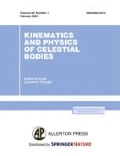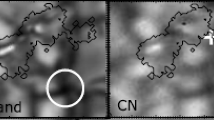Abstract
The Earth’s magnetosphere and the ambient interplanetary environment can create favorable conditions for the nonlinear process of energy release in the form of changes in the topology of the magnetic field and current systems, particle acceleration, wave generation, and sharp gradients in the parameters inherent to a substorm phenomenon. Initially, early studies substantiated the role of variations in the solar wind parameters as a key factor responsible for the onset of a magnetospheric substorm; however, this factor was later shown not to be decisive. Over several decades, continuously improving methods for designing measurement tools and analyzing data helped to identify the processes that accompany the substorm phenomenon and describe them both qualitatively and quantitatively. However, there is no consensus in understanding the scenario of substorm development stepwise. The purpose of the research is to determine the propagation and orientation features of transients (fronts) in the current sheet of the Earth’s magnetotail during a substorm. To do this, the magnetic field measurements obtained by the four spacecraft of the Cluster II mission for July 20, 2013, are analyzed. During this event, spacecraft were located on the night side of the Earth’s magnetosphere and recorded changes in the geomagnetic field during the magnetospheric substorm. We used the single-spacecraft method for finding the minimum variance of the magnetic field and multispacecraft timing analysis involving cross-correlation of time series. The first method allows finding the direction of the normal to the structure under study; the second method makes it possible to find the direction and absolute value of its propagation velocity. The results of the study show that, with the development of substorms, the fronts that move towards the Earth exhibit a decrease in the propagation velocity and a significant degree of curvature. The first effect (a decrease in the propagation velocity of the fronts) indicates a decrease in the energy reserve of the current sheet for the generation of such transients, and the second effect (a significant degree of curvature) indicates the azimuthal localization of the front.


Similar content being viewed by others
REFERENCES
A. Balogh, C. M. Carr, M. H. Acuna, M. W. Dunlop, T. J. Beek, P. Brown, et al., “The cluster magnetic field investigation: Overview of in-flight performance and initial results,” Ann. Geophys. 19, 1207–1217 (2001).
C. C. Harvey, “Spatial gradients and volumetric tensor,” in Analysis Methods for Multi-Spacecraft Data, Ed. by G. Paschmann and P. Daly (European Space Agency, Noordwijk, 1998), pp. 307–322.
L. V. Kozak, B. A. Petrenko, A. T. Y. Lui, et al., “Turbulent processes in the Earth’s magnetotail: Spectral and statistical research,” Ann. Geophys. 36, 1308–1318 (2018).
K. M. Laundal and A. D. Richmond, “Magnetic coordinate systems,” Space Sci. Rev. 206, 27–59 (2017).
A. Lui, “Evidence for two types of dipolarization in the Earth’s magnetotail,” J. Atmos. Sol.-Terr. Phys. 115–116, 17–24 (2014).
V. G. Merkin, E. V. Panov, K. Sorathia, and A. Y. Ukhorskiy, “Contribution of bursty bulk flows to the global dipolarization of the magnetotail during an isolated substorm,” J. Geophys. Res.: Space Phys. 124, 8647–8668 (2019).
R. Nakamura, W. Baumjohann, B. Klecker, et al., “Motion of the dipolarization front during a flow burst event observed by Cluster,” Geophys. Res. Lett. 29, 20 (2002).
E. I. Parkhomenko, H. V. Malova, V. Y. Popov, et al., “Modeling of magnetic dipolarizations and turbulence in Earth’s magnetotail as factors of plasma acceleration and transfer,” Cosmic Res. 56, 453–461 (2018).
A. Runov, V. Angelopoulos, X.-Z. Zhou, X.-J. Zhang, S. Li, F. Plaschke, and J. Bonnell, “A THEMIS multicase study of dipolarization fronts in the magnetotail plasma sheet,” J. Geophys. Res.: Space Phys. 116, A05216 (2011).
Q. Q. Shi, A. M. Tian, S. C. Bai, H. Hasegawa, A. W. Degeling, et al., “Dimensionality, coordinate system and reference frame for analysis of in-situ space plasma and field data,” Space Sci. Rev. 215, 35 (2019).
M. Sitnov, “Explosive magnetotail activity,” Space Sci. Rev. 215, 31 (2019).
B. U. Ö. Sonnerup and L. J. Cahill, “Magnetopause structure and attitude from Explorer 12 observations,” J. Geophys. Res. 72, 171 (1967).
B. U. Ö. Sonnerup and M. Scheible, “Minimum and maximum variance analysis,” in Analysis Methods for Multi-Spacecraft Data, Ed. by G. Paschmann and P. Daly (European Space Agency, Noordwijk, 1998), pp. 185–220.
N. A. Tsyganenko, “A magnetospheric magnetic field model with a warped tail current sheet,” Planet. Space Sci. 37, 5–20 (1989).
Funding
The study was carried out in accordance with the targeted comprehensive program of the National Academy of Sciences of Ukraine in plasma physics as part of joint research projects by scientists of the Taras Shevchenko National University of Kyiv and the National Academy of Sciences of Ukraine for 2019–2020 with the support of grant no. 90312 of the Volkswagen Foundation (VW-Stiftung) and the International Space Science Institute (ISSI-BJ), Beijing, China.
Author information
Authors and Affiliations
Corresponding author
Additional information
Translated by M. Chubarova
About this article
Cite this article
Petrenko, B.A., Kozak, L.V. Dynamics of Magnetic Structures during a Magnetospheric Substorm. Kinemat. Phys. Celest. Bodies 36, 238–242 (2020). https://doi.org/10.3103/S0884591320050062
Received:
Revised:
Accepted:
Published:
Issue Date:
DOI: https://doi.org/10.3103/S0884591320050062



